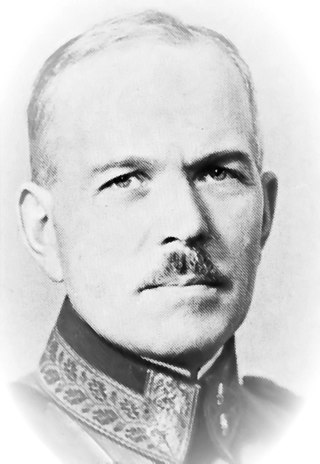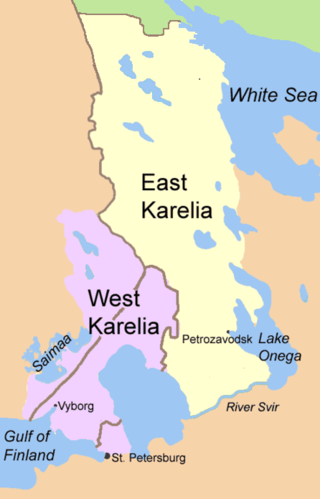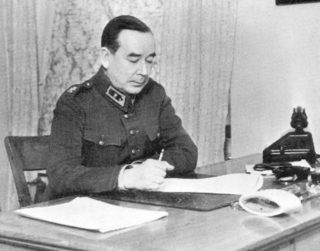Related Research Articles

The Continuation War, also known as the Second Soviet-Finnish War, was a conflict fought by Finland and Nazi Germany against the Soviet Union during World War II. It began with a Finnish declaration of war and invasion on 25 June 1941 and ended on 19 September 1944 with the Moscow Armistice. The Soviet Union and Finland had previously fought the Winter War from 1939 to 1940, which ended with the Soviet failure to conquer Finland and the Moscow Peace Treaty. Numerous reasons have been proposed for the Finnish decision to invade, with regaining territory lost during the Winter War regarded as the most common. Other justifications for the conflict include Finnish President Risto Ryti's vision of a Greater Finland and Commander-in-Chief Carl Gustaf Emil Mannerheim's desire to annex East Karelia.

The Finnish Army is the land forces branch of the Finnish Defence Forces. The Finnish Army is divided into six branches: the infantry, field artillery, anti-aircraft artillery, engineers, signals, and materiel troops. The commander of the Finnish Army since 1 January 2022 is Lieutenant General Pasi Välimäki.

Karl Lennart Oesch was one of Finland's leading generals during World War II. He held a string of high staff assignments and front commands, and at the end of the Continuation War commanded three Finnish army corps on the Karelian Isthmus. He received numerous awards, including the Finnish Mannerheim Cross during his service. Following the end of the Continuation War, he was tried and convicted for war crimes relating to the treatment of Soviet prisoners-of-war.

Karelia is a historical province of Finland, consisting of the modern-day Finnish regions of South Karelia and North Karelia plus the historical regions of Ladoga Karelia and the Karelian isthmus, which are now in Russia. Historical Karelia also extends to the regions of Kymenlaakso, Northern Savonia and Southern Savonia (Mäntyharju).

East Karelia, also rendered as Eastern Karelia or Russian Karelia, is a name for the part of Karelia that since the Treaty of Stolbovo in 1617 has remained Eastern Orthodox and a part of Russia. It is separate from the western part of Karelia, called Finnish Karelia or historically Swedish Karelia. Most of East Karelia has become part of the Republic of Karelia within the Russian Federation. It consists mainly of the old historical regions of Viena Karjala and Aunus Karjala.

Karelia is an area in Northern Europe of historical significance for Russia, Finland, and Sweden. It is currently divided between northwestern Russia and Finland.

Finland participated in the Second World War initially in a defensive war against the Soviet Union, followed by another, this time offensive, war against the Soviet Union acting in concert with Nazi Germany and then finally fighting alongside the Allies against Germany.

The Academic Karelia Society was a Finnish nationalist and Finno-Ugric activist organization aiming at the growth and improvement of newly independent Finland, founded by academics and students of the University of Finland in 1922. Its members retained influential positions in the academic life of the era as well as within the officer corps of the Army. The AKS controlled the student union of the University of Helsinki from the mid-1920s right up to 1944, when the Society was disbanded in the aftermath of the Continuation War.

Greater Finland, was an irredentist and nationalist idea that was a subset of Pan-Finnicism which emphasized the territorial expansion of Finland. The most common concept of Greater Finland saw the country as defined by natural borders encompassing the territories inhabited by Finns and Karelians, ranging from the White Sea to Lake Onega and along the Svir River and Neva River—or, more modestly, the Sestra River—to the Gulf of Finland. Some proponents also included the Torne Valley, Ingria, and Estonia.

The Karelian people's presence can be dated back to the 7th millennium BC–6th millennium BC. The region itself is rich with fish, lakes, and minerals, and because of that throughout history changed its holder, to this day divided between the Republic of Finland and the Russian Republic.
There were two waves of the Finnish prisoners of war in the Soviet Union during World War II: POWs during the Winter War and the Continuation War.

Johan Woldemar Hägglund was a Finnish lieutenant general in the Finnish Army in the Second World War, and an early volunteer of the Jäger Movement. He participated in the Eastern Front of World War I, the Finnish Civil War, the Winter War and the Continuation War, commanding army corps in the latter two. Between 1944 and 1945, he was in charge of a committee investigating Finnish war crimes, especially those committed against prisoners-of-war.

The Finnish military administration in Eastern Karelia was an interim administrative system established in those areas of the Karelo-Finnish Soviet Socialist Republic (KFSSR) of the Soviet Union which were occupied by the Finnish army during the Continuation War. The military administration was set up on 15 July 1941 and it ended during the summer of 1944. The goal of the administration was to prepare the region for eventual annexation by Finland.

Soviet prisoners of war in Finland during World War II were captured in two Soviet-Finnish conflicts of that period: the Winter War and the Continuation War. The Finns took about 5,700 POWs during the Winter War, and due to the short length of the war they survived relatively well. However, during the Continuation War the Finns took 64,000 POWs, of whom almost 30 percent died.
Severin Tsezarevich Dobrovolsky was a Russian White émigré, who lived after the Russian Civil War as a political refugee in Finland. He participated in the activities of several white emigrant organizations and published pro-fascist Russian-language magazines. Dobrovolsky was turned over to the Soviet Union in 1945, where he was sentenced to death and executed.
Lennart Reidar Armas Hedman was a Finnish educator, eugenist and far-right politician. He had a master's degree in philosophy. He had studied genetics at the University of Helsinki under Harry Federley.
Thoralf Kyrre was a Danish engineer who was involved in the pro-German resistance movement in Finland from 1944 to 1945.

Aarne Emil Kauhanen was a Finnish officer of the Central Detective Police (EK) and its successor, the State Police (ValPo), with special responsibility for aliens in the 1930s and 1940s. During the Continuation War, he acted as a liaison between the Finnish and Nazi German police authorities and was involved in the recruitment of the Finnish SS Battalion. Kauhanen also beat and tortured Jewish refugees during interrogations. After the war, he escaped to South America, where Kauhanen died in unclear circumstances in 1949. According to a memoir, one of his victims recognized and later shot him.

Unto Ilmari Parvilahti was a Finnish photographer and businessman who served from 1941 to 1944 as the head of the liaison office of the volunteer Finnish SS battalion in Berlin. After being handed over to the Soviet Union among the so-called Leino prisoners in 1945, he spent several years there in prison camps. After returning to Finland, he wrote the memoir Beria's Gardens (1957), in which he describes Soviet prisons based on his own experiences. He was an ardent supporter of Nazism.
References
- ↑ Laine, Antti 1982: Suur-Suomen kahdet kasvot. Itä-Karjalan siviiliväestön asema suomalaisessa miehityshallinnossa 1941–1944, s. 63, 67, 116, 125. Helsinki: Otava.
- ↑ Kinnunen, Tiina; Kivimäki, Ville (2011-11-25). Finland in World War II: History, Memory, Interpretations. BRILL. p. 389. ISBN 978-90-04-20894-0.
- ↑ Maanpuolustuskorkeakoulun historian laitos, Jatkosodan historia 1–6 ("The History of The Continuation War, 1–6"), 1994
- ↑ Westerlund 2008, p. 8
- ↑ ""Равнение на Победу" (Eyes toward victory), the Republic of Karelia" (in Russian). the Ministry of Education and Science of the Russian Federation, National Delphi Council of Russia. Archived from the original on 2005-11-02. Retrieved 2006-08-10.